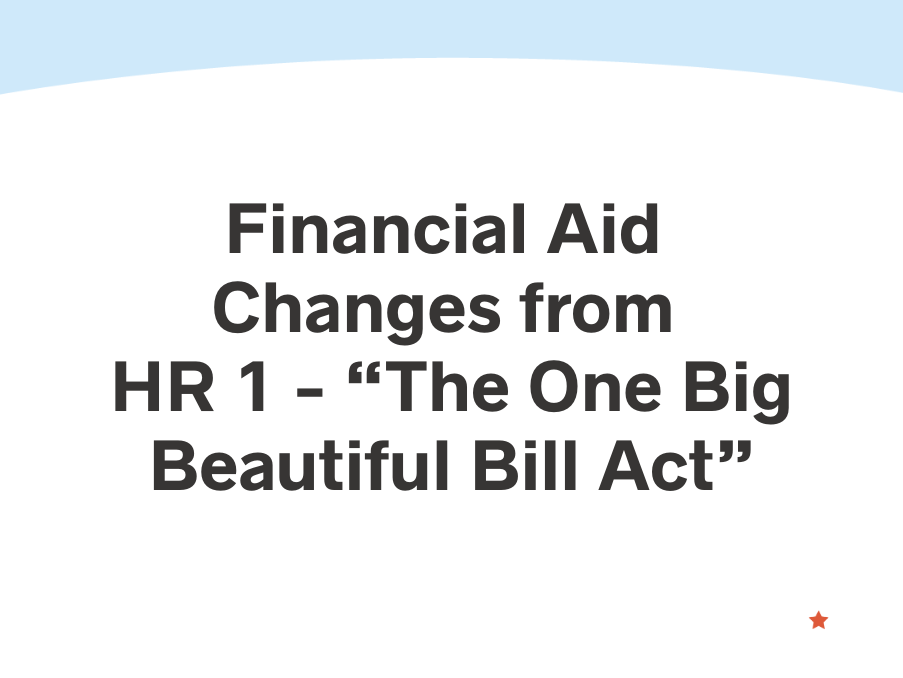News
Financial Aid Changes from HR 1 - “The One Big Beautiful Bill Act”
August 25, 2025
By Anika Van Eaton
.png)
Changes are coming to student loans, repayment programs, and higher education. HR 1 – “The One Big Beautiful Bill Act” – passed through reconciliation, a process that allows Congress to approve certain budget-related changes with a simple majority instead of the usual 60 Senate votes. The bill passed along party lines, with most Republicans in support, and President Trump signed it into law on July 4, 2025. Most higher education provisions take effect on July 1, 2026.
At a high level, HR 1 reduces federal revenue by $4.5 trillion over the next decade by making the 2017 Tax Cuts and Jobs Act permanent. The law cuts $3.5 trillion in spending to offset this, largely targeting federal social programs. While HR 1 includes significant changes to tax policy, healthcare, and food assistance programs, this blog focuses only on the provisions for financial aid.
What Stays the Same
-
Pell Grants are preserved: The program receives a $10 billion boost for the federal fiscal year (Oct. 1, 2025 – Sept. 30, 2026) to prevent a projected shortfall.
-
Federal Direct Loans remain available: Subsidized and unsubsidized undergraduate loans are still available to undergraduates and have the same annual and aggregate loan limits.
FAFSA and Student Aid Eligibility
Starting with the 2026–27 FAFSA (available Oct. 1, 2025), several changes will affect eligibility:
-
Asset exclusions expanded: Families no longer have to report the net worth of a small business (≤100 employees), a family farm they live on, or a family-owned commercial fishing business.
-
Foreign income counted: Foreign earned income will be added to adjusted gross income (AGI) for Pell Grant calculations.
-
Pell eligibility tightened: Students with a Student Aid Index (SAI) at or above twice the maximum Pell Grant award will be ineligible, closing off Pell access for families with low incomes but high-value assets.
Student Loans
Undergraduate Loans
-
Enrollment intensity caps: Annual loan amounts will be prorated based on enrollment status (e.g., half-time students will only be eligible for half the annual loan amount).
-
Institutional caps: Colleges may set their own program-level borrowing limits.
Parent PLUS Loans
-
New caps imposed: Parent PLUS loan borrowing is limited to $20,000 per year per dependent student and $65,000 lifetime total per student.
Graduate and Professional Students
-
Grad PLUS eliminated: Students enrolling in graduate programs after July 1, 2026 will no longer be eligible. Students starting in 2025–26 may borrow Grad PLUS for that year and up to three more years (or the program length, whichever is shorter).
-
Direct Unsubsidized Loans split: Graduate students can borrow up to $20,500 in Direct Unsubsidized Loans each year, with a lifetime borrowing cap of $100,000. Professional students, on the other hand, are eligible to borrow up to $50,000 annually, with a lifetime maximum of $200,000.
Student Loan Repayment
For loans issued on or after July 1, 2026, two repayment options will be available:
-
Standard Repayment Plan: Fixed monthly payments over 10–25 years, depending on total borrowed.
-
Repayment Assistance Plan (RAP): Income-based payments ranging from 1–10% of AGI, with unpaid interest forgiven and a $50 monthly principal match. Loans are forgiven after 30 years.
For current borrowers, the SAVE, PAYE, and ICR plans will phase out between 2026–2028. Borrowers will transition into RAP, an amended IBR plan, or a standard repayment option. The Institute for College Access & Success (TICAS) has a detailed analysis of these changes.
Workforce Pell Grants
HR 1 creates a new Workforce Pell Grant for accredited short-term training programs (150–600 clock hours or 8–15 weeks). This opens eligibility to some certificate programs that were previously excluded.
The Department of Education will set regulations on program outcomes and quality through a “negotiated rulemaking” process. Implementation may take until 2027, depending on how quickly the rules are finalized. The organization Jobs for the Future posted a blog with more details about Workforce Pell.